
— Kris Ashton
For many years now, Mazda has positioned itself as a quasi-luxury brand, offering quality superior to the bread-and-butter Japanese and Korean marques but not quite pricing itself out of the mainstream market.
The automotive world has seen rapid change in recent times, however, and that poses a problem for the brand’s older models such as the Mazda CX-3, the smallest SUV in its lineup. Updates notwithstanding, this is a ten-year-old vehicle – and juxtaposed with the latest light and small SUV entrants, it feels like it.
Are rock-solid build quality and a refined drivetrain still enough when so many alternatives are available in 2025?
The four-step 2025 Mazda CX-3 range kicks off with the Pure (our test vehicle) for $30,370 before on road costs, then moves through the Evolve ($32,100) and GT SP ($35,330) before topping out at the Akari for $38,890.
Not so long ago, $30k for a light SUV would have been deemed daylight robbery, but the price bracket has crept up in recent years. The CX-3 costs less than the Toyota Yaris Cross ($31,790) and Volkswagen T-Cross ($33,990), but substantially more than the Hyundai Venue ($25,000), Kia Stonic ($26,160) and Suzuki Fronx ($28,990).
Chinese makers have altered the equation, too, with small SUVs going for a light SUV price. The Chery Tiggo 4 – while hard to recommend – starts at a mere $21,990, and the MG ZS is available from $25,990.
Even though Mazda has treated the CX-3 to regular updates over the years, the dash layout is beginning to feel like a relic from another era.
The instrument cluster is dominated by an analogue tachometer with a small digital speedo tucked away beneath it. A head-up display, ironically, makes the latter obsolete anyway.
Dials and buttons dominate the dashboard and centre console, with the small central touchscreen also operable via a knob – no doubt a feature rather than a bug to Mazda’s typically older demographic. Device connections in the Pure are limited to two USB-A slots, with no USB-C ports available. Quaint!
Increasingly archaic technology aside, it’s plain to see why the Mazda CX-3 remains one of the top-selling light SUVs. Interior styling is simple but elegant, even in the base model (up-spec interiors become more lavish and ostentatious), and the seats are comfortable for the long haul. There’s a single but cleverly designed drink holder, dials for the air conditioning, more shortcut buttons for the infotainment system, and a volume knob in convenient reach.
The steering wheel is leather-bound, as is the lid on the centre armrest, and ‘cramped’ is certainly not a word you would use to describe the cabin up front. Perhaps most noteworthy for the light SUV segment, nothing about the CX-3 feels cheap or scratchy.
Second row foot and shoulder space isn’t bad, although knee room is limited (even with the front seat backs hollowed out) and a six-footer’s head will be pushing into the roof. The seats themselves are well padded (if a tad shapeless) and upholstered in fabric that won’t irritate bare legs in summer.
Back seat ‘luxuries’ in the Pure amount to electric windows, two cup holders in the fold-down armrest, and an angled drink holder in each door pocket. Three top tether and two Isofix anchor points are provided, although two child restraints are as many as you’ll fit across the second row at one time.
Mazda’s vehicles generally aren’t renowned for their cargo space, either, and the CX-3’s boot offers just 264 litres, which means it’s maxed out at a large suitcase. That said, it has a useful 1000mm width and if the second row is folded down it creates a handy 1174 litre load space. Under the boot floor resides a space saver spare wheels.
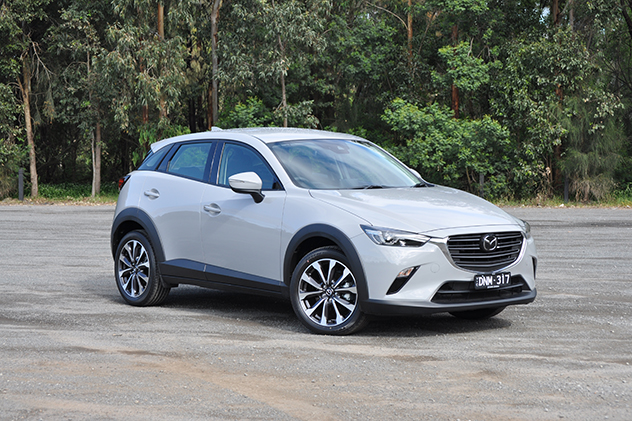
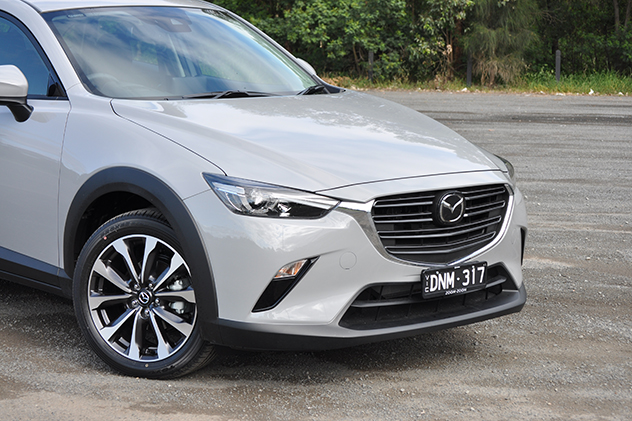
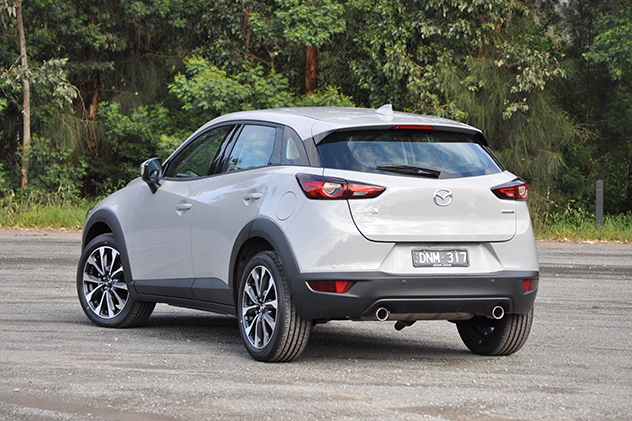
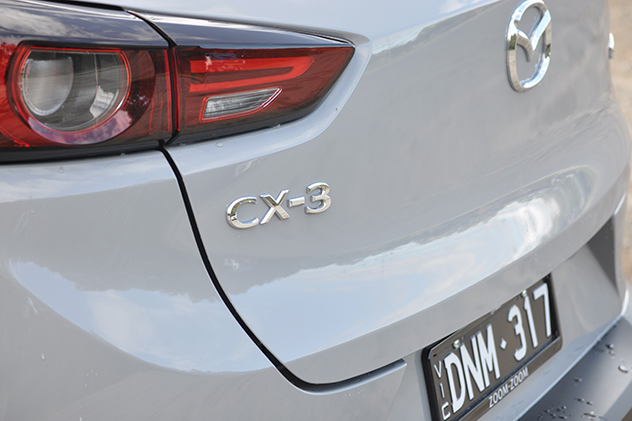
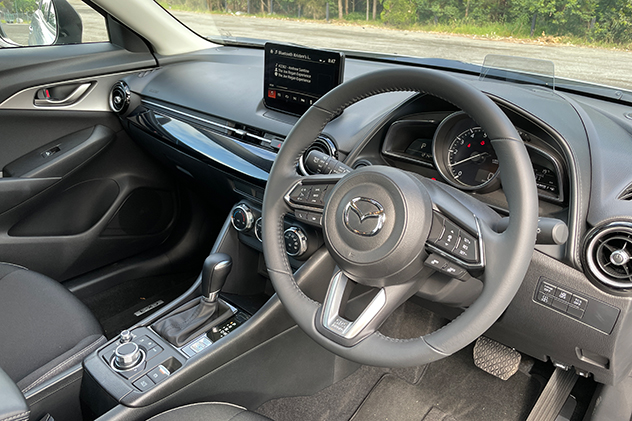
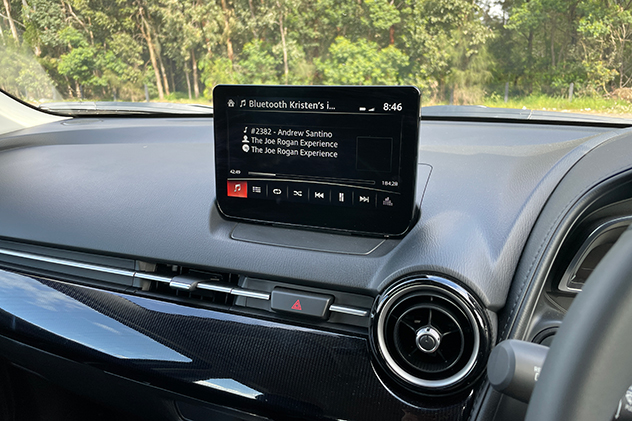
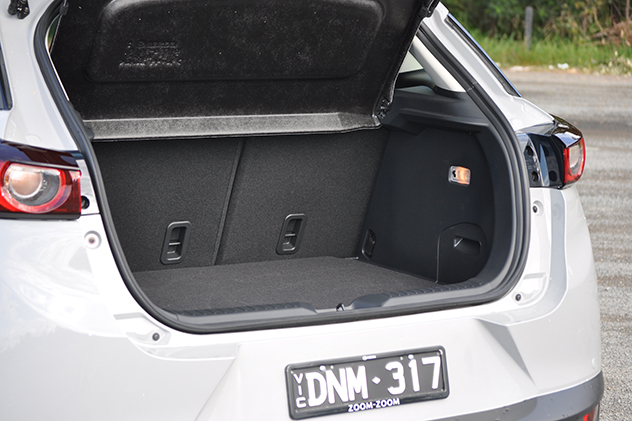
The smaller end of the market is increasingly about ‘quality vs stuff’ and, as Mazda lands on the ‘quality’ side, the CX-3 Pure isn’t loaded with kit for its $30,370 retail price.
Standard features include 18-inch alloy wheels, push button start (but not keyless entry), an 8.0-inch infotainment system, six-speaker sound system, head-up display, wireless Apple CarPlay, digital radio, sat nav, rain sensing wipers, and a leather steering wheel.
Keyless entry makes its debut in the Evolve, as do black machined 18-inch alloys, front fog lamps and faux leather upholstery.
The GT SP moves up to 18-inch black metallic alloys, leather seats with synthetic suede trim, power adjustable driver’s seat, seven-speaker Bose audio system, and traffic sign recognition as part of its safety suite.
Opting for the top-spec Akari entitles you to 18-inch ‘bright’ alloys, a sunroof, full leather seat upholstery, and a 360-degree view monitor.
All models are covered by a five-year/unlimited-kilometre warranty, with 15,000km/12-month service intervals. Each service costs between $353 and $554.
Until 2022, the Mazda CX-3 had a five-star ANCAP rating, but the latest models have not been crash-tested.
Safety equipment includes six airbags, blind-spot monitoring, driver attention alert, high-beam control, lane departure warning, rear cross-traffic alert, and a reversing camera.
The 2.0-litre direct injection four-cylinder petrol engine used across the range has been on duty in the CX-3 since the start. In the current model it produces 110kW and 195Nm – impressive ten years ago, and still right up there with the best in 2025. It’s matched to a six-speed transmission.
Unlike an increasingly large number of its competitors, the Mazda CX-3 can accept E10 and 91RON unleaded petrol. Claimed fuel consumption is 6.3L/100km, which isn’t amazing compared to the new crop of hybrids, but isn’t bad, either.
While the CX-3’s drivetrain might seem long in the tooth in the turbo/hybrid era, Mazda has spent a decade or more fettling it and exudes smoothness and refinement.
It’s equally at home zipping around the suburbs or cruising on the motorway and, whereas some budget vehicles labour along with a transmission that hunts and hunts for the right gear, the Mazda CX-3’s no-fuss six-speed has ESP by comparison, delivering power without frustrating lag time or engine flare.
Sport mode revises engine mapping so the CX-3 holds its revs and provides more immediate throttle response, ideal for a winding country pass.
Ride is biased towards comfort and, by modern SUV standards, the suspension borders on bouncy. Handling, therefore, is not what you’d call sporty, although it’s far from sloppy and the driving dynamics are well suited to the urban environments in which this SUV will likely find itself.
Bump absorption is good, rearward vision is excellent, and the CX-3 is as easy to park as you’d expect, although the low-resolution reversing camera image is yet another indication this model is getting on in years.
Moving forward in the wrong direction isn’t progress, and the Mazda CX-3 is a good example of a superior car remaining at the forefront of its category while largely standing still.
Yes, its infotainment technology is starting to resemble a museum exhibit and, no, it’s not going to be the budget-conscious buyer’s first choice. But if you’re seeking a well-built light SUV that delivers on the basics with no peccadilloes or unpleasant surprises, the Mazda CX-3 continues to be a compelling option.